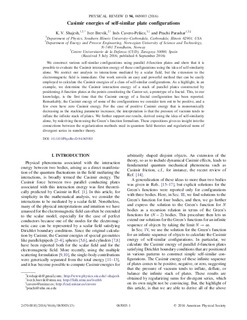Casimir energies of self-similar plate configurations
Journal article, Peer reviewed
Published version
Permanent lenke
http://hdl.handle.net/11250/2472812Utgivelsesdato
2016Metadata
Vis full innførselSamlinger
Sammendrag
We construct various self-similar configurations using parallel δ-function plates and show that it is possible to evaluate the Casimir interaction energy of these configurations using the idea of self-similarity alone. We restrict our analysis to interactions mediated by a scalar field, but the extension to the electromagnetic field is immediate. Our work unveils an easy and powerful method that can be easily employed to calculate the Casimir energies of a class of self-similar configurations. As a highlight, in an example, we determine the Casimir interaction energy of a stack of parallel plates constructed by positioning δ-function plates at the points constituting the Cantor set, a prototype of a fractal. This, to our knowledge, is the first time that the Casimir energy of a fractal configuration has been reported. Remarkably, the Casimir energy of some of the configurations we consider turn out to be positive, and a few even have zero Casimir energy. For the case of positive Casimir energy that is monotonically decreasing as the stacking parameter increases, the interpretation is that the pressure of vacuum tends to inflate the infinite stack of plates. We further support our results, derived using the idea of self-similarity alone, by rederiving them using the Green’s function formalism. These expositions gives us insight into the connections between the regularization methods used in quantum field theories and regularized sums of divergent series in number theory.
